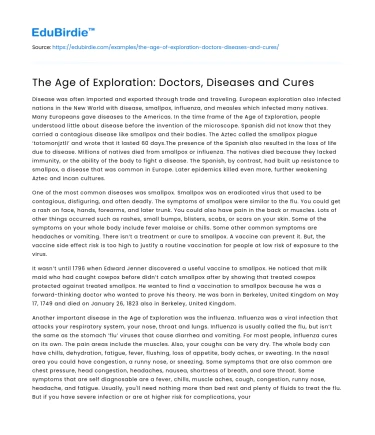Disease was often imported and exported through trade and traveling. European exploration also infected nations in the New World with disease, smallpox, influenza, and measles which infected many natives. Many Europeans gave diseases to the Americas. In the time frame of the Age of Exploration, people understood little about disease before the invention of the microscope. Spanish did not know that they carried a contagious disease like smallpox and their bodies. The Aztec called the smallpox plague ‘totomonjztli’ and wrote that it lasted 60 days.The presence of the Spanish also resulted in the loss of life due to disease. Millions of natives died from smallpox or influenza. The natives died because they lacked immunity, or the ability of the body to fight a disease. The Spanish, by contrast, had built up resistance to smallpox, a disease that was common in Europe. Later epidemics killed even more, further weakening Aztec and Incan cultures.
One of the most common diseases was smallpox. Smallpox was an eradicated virus that used to be contagious, disfiguring, and often deadly. The symptoms of smallpox were similar to the flu. You could get a rash on face, hands, forearms, and later trunk. You could also have pain in the back or muscles. Lots of other things occurred such as rashes, small bumps, blisters, scabs, or scars on your skin. Some of the symptoms on your whole body include fever malaise or chills. Some other common symptoms are headaches or vomiting. There isn’t a treatment or cure to smallpox. A vaccine can prevent it. But, the vaccine side effect risk is too high to justify a routine vaccination for people at low risk of exposure to the virus.
It wasn’t until 1796 when Edward Jenner discovered a useful vaccine to smallpox. He noticed that milk maid who had caught cowpox before didn’t catch smallpox after by showing that treated cowpox protected against treated smallpox. He wanted to find a vaccination to smallpox because he was a forward-thinking doctor who wanted to prove his theory. He was born in Berkeley, United Kingdom on May 17, 1749 and died on January 26, 1823 also in Berkeley, United Kingdom.
Another important disease in the Age of Exploration was the influenza. Influenza was a viral infection that attacks your respiratory system, your nose, throat and lungs. Influenza is usually called the flu, but isn’t the same as the stomach ‘flu’ viruses that cause diarrhea and vomiting. For most people, influenza cures on its own. The pain areas include the muscles. Also, your coughs can be very dry. The whole body can have chills, dehydration, fatigue, fever, flushing, loss of appetite, body aches, or sweating. In the nasal area you could have congestion, a runny nose, or sneezing. Some symptoms that are also common are chest pressure, head congestion, headaches, nausea, shortness of breath, and sore throat. Some symptoms that are self diagnosable are a fever, chills, muscle aches, cough, congestion, runny nose, headache, and fatigue. Usually, you'll need nothing more than bed rest and plenty of fluids to treat the flu. But if you have severe infection or are at higher risk for complications, your doctor may prescribe an antiviral medication.
One of the doctors in the Age of Exploration was William Harvey. William Harvey was a English Physician. William Harvey was the first person to describe blood's circulation in the body correctly. He showed that arteries and veins form a complete circuit. The circuit starts at the heart and leads back to the heart. The heart's regular contractions drive the flow of blood around the whole body. He was also the person to discover the human heart. He was born in Folkestone, United Kingdom on April. 1, 1578 and died on June. 3, 1657 in Roehampton, London, United Kingdom.
Another famous doctor was Ambroise Paré, a French barber surgeon. He is considered to be one of the most important people of surgery and modern forensic pathology and good in surgical techniques and battlefield medicine. He was born in 1510 in Laval, France. He died on December 20, 1590 in Paris, France. By 1552 he had he had become so popular that he became surgeon to the king, he served 4 French monarchs: Henry II, Francis II, Charles IX, and Henry III.
As you can see, doctors, diseases, and cures shape lots of history and the people that were in it. Doctors help cure and discover, diseases change, form, and impact people, and cures help others survive.






 Stuck on your essay?
Stuck on your essay?

